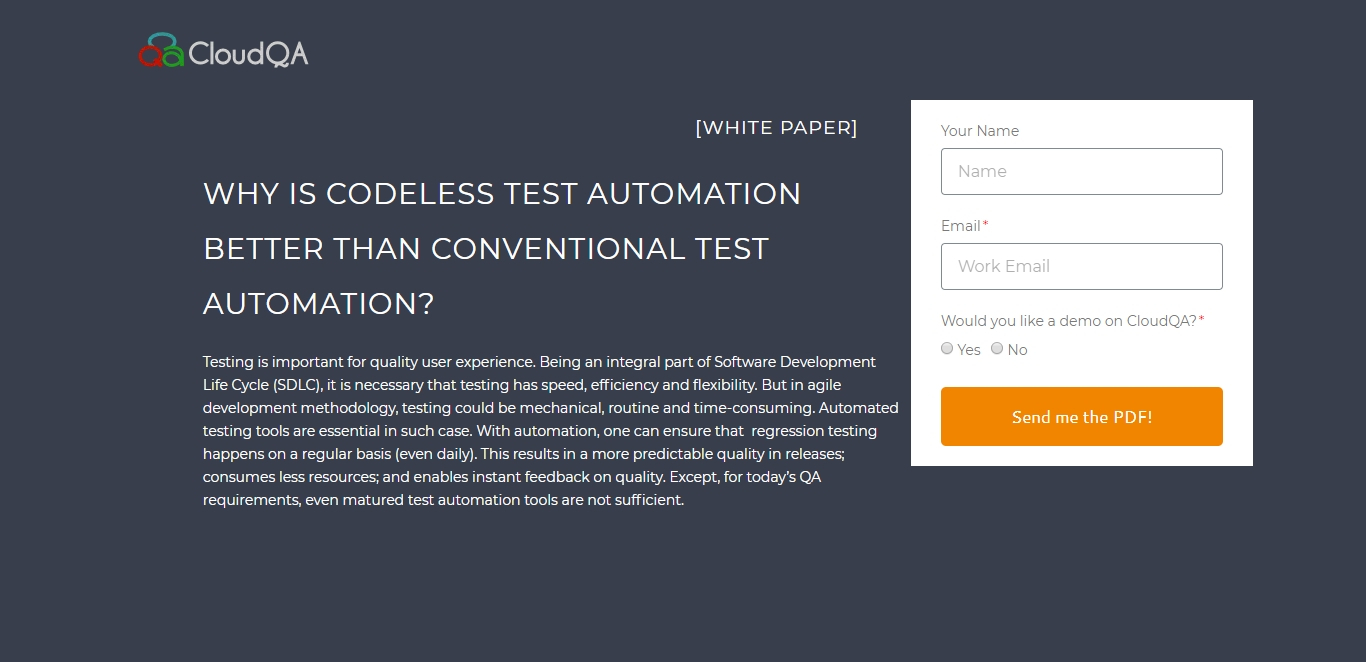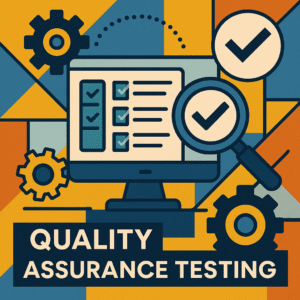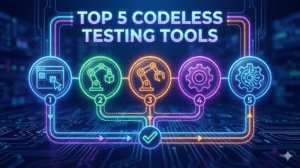Future Trends in Test Automation: What to Expect in the Next 5 Years
Last Updated: 18/08/2025
As a quality assurance professional, you can stay ahead of the curve by understanding the trends that are shaping the future of testing. Discover how CloudQA’s modern, codeless platform can equip you for the changes ahead.
Table of Contents
Introduction: Thriving Through Change in the World of QA
In the ever-evolving landscape of technology, questions about the future are natural. “Will AI replace me?” or “Could the looming recession put my career at risk?” While no one can predict the future with certainty, what remains within our control is how we prepare for it. Navigating the shifting terrain of software testing requires us to be informed, adaptive, and proactive.
The key to not just sustaining a career but thriving through every wave of change lies in a commitment to continuous growth. This involves:
- Equipping yourself with the latest knowledge in your field.
- Keeping up with emerging trends in QA and software testing automation.
- Continually refining your skills and expanding your professional network.
The year 2025 is proving to be a pivotal, innovation-driven year for software testing and Quality Assurance (QA). The acceleration of digital transformation has set several powerful trends in motion that will define not just the year ahead, but the entire decade. This guide provides a comprehensive overview of these key trends to help you prepare for the future of quality assurance.
Trend 1: AI-Based QA Transformations
What It Is: Artificial Intelligence (AI) in QA involves using intelligent algorithms to create smarter, faster, and more efficient testing processes. This goes far beyond simple automation. AI can analyze vast amounts of data-from past bug reports to user behavior logs-to automatically generate new test cases, intelligently prioritize testing efforts, and even predict where future defects are most likely to occur. This capability drastically reduces manual effort while simultaneously improving test accuracy and coverage.
Why It Matters: As software complexity grows, it becomes impossible for humans to test every possible scenario. AI acts as a powerful force multiplier for QA teams. By predicting high-risk areas of an application, it allows testers to focus their limited time and attention where it’s needed most, long before critical issues arise.
Growth and Adoption:
- 2015-2017: AI made its initial entry into the QA space, primarily through tools using machine learning for simple test case generation.
- 2018-2020: The technology became more sophisticated, with AI gaining self-learning capabilities to predict failures and optimize test coverage.
- 2021-Present: The market has surged, driven by advancements in no-code test automation and self-healing technologies. Major tech companies like Google, Facebook, and IBM have fully integrated AI into their QA procedures, reporting significant gains in both quality and speed.
- Market Projection: According to Forrester, the AI-driven testing market is projected to grow from $600 million in 2020 to over $3 billion by 2025.
Trend 2: Explainable AI (XAI)
What It Is: Explainable AI (XAI) is a principle holding that AI systems should be designed with human-friendly decision-making processes. In essence, an XAI system doesn’t just give you an answer; it shows you its work. For QA, this means understanding the reasoning behind an AI’s recommendations, such as why it flagged a particular area as high-risk or why it generated a specific test case.
Why It Matters: Trust is essential for collaboration. XAI builds confidence in the AI’s output by making its processes transparent. This is crucial in regulated industries like finance and healthcare, where accountability is paramount. It allows testers to work more productively with AI systems, verify their conclusions, and ultimately maintain accuracy and accountability in the testing process.
Growth and Adoption:
- 2017-2020: XAI began its journey from a niche academic concept to a practical consideration in QA.
- 2021-Present: Major corporations started to incorporate XAI into their AI-driven QA solutions, sparking widespread adoption.
- Market Projection: A 2022 Forrester analysis predicts the market for explainable AI will grow at a CAGR of 23.5%, from $2.4 billion in 2021 to over $12.6 billion by 2030.
Trend 3: Self-Healing Automation Tools
What It Is: Self-healing technologies are systems capable of automatically detecting and fixing problems in test scripts without human intervention. Test automation has long been plagued by “brittle” tests that break due to minor, often cosmetic, changes in an application’s codebase or UI. Self-healing tools use AI to understand that even if a button’s ID or location has changed, it’s still the same functional element. They adapt to these shifts on the fly, dramatically reducing maintenance time.
Why It Matters: Test maintenance is one of the biggest hidden costs of automation. Self-healing tools allow testers to escape the endless cycle of fixing broken tests and focus on higher-value activities, such as exploratory testing and designing new test strategies.
Growth and Adoption:
- 2016: SmartBear released self-healing tools that could dynamically adapt to UI changes, reducing test maintenance by a reported 40%.
- 2019: Platforms like Testim and Katalon integrated AI-driven self-healing, further increasing test stability and cutting manual test tweaks by 60%.
- 2021: Mabl introduced predictive AI-driven self-healing that increased test automation stability by 70% and integrated seamlessly into CI/CD pipelines.
- Market Projection: The global market for self-healing technologies is expected to expand from $1.4 billion in 2020 to $5.6 billion by 2026, reflecting a robust CAGR of 25.4%.
Trend 4: No-Code and Codeless Test Automation
What It Is: No-code or codeless test automation platforms empower testers with little to no programming experience to create sophisticated automated test cases using intuitive drag-and-drop interfaces and visual workflows. This approach “democratizes” test automation, making it accessible to a much wider range of QA professionals, business analysts, and product managers.
Why It Matters: This trend breaks down the bottleneck created by relying on a small team of specialized automation developers. It facilitates faster testing iterations and allows the people with the deepest functional knowledge of the application to directly contribute to building the automation suite.
Growth and Adoption:
- 2017–2019: Platforms like CloudQA and Testim.io pioneered codeless testing tools, enabling QA teams to automate without deep programming skills.
- 2020–2022: Enhanced no-code features led to a 30% increase in test automation adoption, particularly among non-technical QA teams.
- 2025 and Beyond: In 2025, no-code automation is expected to comprise 45% of the test automation tool market, making it a critical component for modern, agile teams.
Trend 5: The Maturation of Shift-Left Testing
What It Is: Shift-left testing is the practice of moving testing activities earlier in the software development lifecycle. Traditionally, testing was a distinct phase that occurred on the “right” side of the process, after development was complete. The shift-left approach integrates testing directly into the design and development phases.
Why It Matters: Finding and fixing a defect early in the development cycle is exponentially cheaper and faster than fixing it after the code has been released. This method ensures higher quality from the start and is a cornerstone of modern Agile and DevOps workflows.
Growth and Adoption:
- 2016–2020: Shift-left testing became a mainstream practice, with 40% of organizations incorporating QA into their development processes, leading to a 30% reduction in defects.
- 2025 and Beyond: In 2025, an estimated 70% of companies have fully embedded shift-left testing in their DevOps workflows to achieve faster, higher-quality software releases.
Trend 6: Advanced Test Data Management (TDM)
What It Is: As businesses handle increasingly large and complex datasets, Test Data Management (TDM) has become highly sophisticated. Advanced TDM involves creating high-quality synthetic test data, ensuring sensitive information (like personal data) is protected, and guaranteeing that all test cases have complete and relevant data coverage.
Why It Matters: The quality of testing is only as good as the quality of the test data. Richer, more realistic test data allows QA teams to simulate real-world environments more accurately, leading to better testing outcomes and higher confidence in the results. AI-driven TDM tools can now generate smart, context-aware data, further enhancing this capability.
Trend 7: The Dawn of Quantum Computing in QA
What It Is: While still in its infancy, quantum computing is expected to have a revolutionary impact on QA over the next decade. Quantum computers can process massive volumes of data at speeds that are unimaginable for classical computers.
Why It Matters: This immense power will benefit QA by enabling the testing of extremely complex algorithms, making advancements in cryptography testing, and executing complex test cases much more quickly. As quantum technology matures, it will unlock entirely new and more potent testing methods. By 2033, quantum-powered QA tools are likely to become standard.
Trend 8: The Rise of Blockchain Testing
What It Is: With the increasing adoption of blockchain technology, a new, specialized field of testing has emerged. Blockchain testing focuses on guaranteeing the security, performance, and functionality of decentralized applications (dApps).
Why It Matters: This is a critical area of focus that involves verifying the integrity of smart contracts, testing for vulnerabilities in decentralized networks, and ensuring compliance with regulatory standards. As interoperability between different blockchain networks becomes more important, testing the smooth communication and integration between them will be essential.
How to Prepare for the Future of QA
Embracing these trends requires proactive effort. Here are actionable steps QA professionals can take to stay relevant and competitive:
- Invest in AI Literacy: You don’t need to become an AI developer, but understanding the basic principles of machine learning and how AI is applied in testing tools will be crucial.
- Master a Modern Tool: Gain hands-on experience with a platform that incorporates these trends, such as a no-code tool with AI-driven, self-healing capabilities.
- Think Like a Strategist: With AI handling repetitive tasks, the role of the QA professional will become more strategic. Focus on developing skills in test planning, risk analysis, and exploratory testing.
- Stay Curious: Follow industry leaders, read white papers, and participate in webinars about emerging technologies like quantum computing and blockchain to understand their potential impact on your work.
Conclusion: A Future of Opportunity
The field of quality assurance is rapidly evolving, driven by technological advancements in AI, no-code automation, shift-left testing, and more. These technologies and services like CloudQA’s Test Automation as a Service are reshaping the testing process, improving efficiency, and enabling organizations to deliver higher-quality software faster than ever before.
For professionals in the field, this period of change represents an immense opportunity. Artificial intelligence isn’t here to steal jobs; it’s here to make them easier and more strategic. By staying knowledgeable, remaining flexible, and continuously investing in skills related to these emerging technologies, QA specialists can not only stay competitive but become indispensable leaders in a world where software quality is more crucial than ever.
RECENT POSTS
Guides

How To Select a Regression Testing Automation Tool For Web Applications
Regression testing is an essential component in a web application development cycle. However, it’s often a time-consuming and tedious task in the QA process.

Switching from Manual to Automated QA Testing
Do you or your team currently test manually and trying to break into test automation? In this article, we outline how can small QA teams make transition from manual to codeless testing to full fledged automated testing.

Why you can’t ignore test planning in agile?
An agile development process seems too dynamic to have a test plan. Most organisations with agile, specially startups, don’t take the documented approach for testing. So, are they losing on something?

Challenges of testing Single Page Applications with Selenium
Single-page web applications are popular for their ability to improve the user experience. Except, test automation for Single-page apps can be difficult and time-consuming. We’ll discuss how you can have a steady quality control without burning time and effort.

Why is Codeless Test Automation better than Conventional Test Automation?
Testing is important for quality user experience. Being an integral part of Software Development Life Cycle (SDLC), it is necessary that testing has speed, efficiency and flexibility. But in agile development methodology, testing could be mechanical, routine and time-consuming.







Comments are closed.